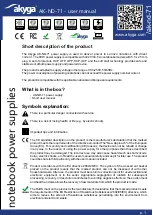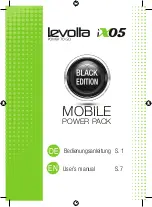
coefficient for 5V remote current programming is 50 millivolts = 1% of rated
output, i.e., for a 300 amp model, each 50 millivolts of programming voltage
equals 3 amps of output current. The voltage coefficient for 10V remote
current programming is 100 millivolts = 1% of rated output, i.e., for a 300 amp
model, each 100 millivolts of programming voltage equals 3 amps of output
current. See Figure 3-4 for connection requirements.
3.4
REMOTE VOLTAGE PROGRAMMING
The remote voltage programming configuration is used for applications that require
the output voltage be programmed (controlled) from a remote source. An external
resistance or external voltage source may be used as a programming device. When
using remote voltage programming, a shielded, twisted-pair, hookup wire is
recommended to prevent noise interference with programming signals.
1. External Voltage Programming Using Resistance. The resistance coefficient
for remote voltage programming is 5k ohms/100% of rated output voltage
with respect to the VP RTN, J1-20. The programming current from terminal
J1-21 (VP-RES) is factory set to 1 milliampere. This yields a coefficient of
1.0% of rated output voltage for each 50 ohms. If multiple switches or relays
are used to program different levels, make-before-break contacts are
recommended. Note that if an external resistance is used for remote
programming, the voltage programming return (VP RTN), terminal J1-20,
must be connected directly to or within ±3 volts of the power supply common
terminal, J1-24 See Figure 3-5 for connection requirements.
2. External Voltage Programming Using a 5 VDC or 10 VDC Voltage Source. A
DC voltage source for remote voltage programming is connected between J1-
9 (VP 5V) or J1-15 (VP 10V) and the return terminal J1-20 (VP RTN). Note
that the return terminal (VP RTN) must be referenced directly to or within ±3V
of the power supply common, J1-24. The voltage coefficient for 5V remote
voltage programming is 5 volts = 100% of rated output voltage. The voltage
coefficient for 10V remote voltage programming is 10 volts = 100% of rated
output voltage. See Figure 3-6 for connection requirements.
3.5
REMOTE
SENSING
In applications where the load is located some distance from the power supply, or the
voltage drop of the power output leads significantly interferes with load regulation,
remote voltage sensing may be used. When remote sensing is used, voltage is
regulated at the load versus the power supply output terminals. To connect the power
supply for remote voltage sensing (see Figure 3-7 for connection requirements),
perform the following procedure.
M550001-01
3-6
Summary of Contents for D3 Series
Page 2: ......
Page 3: ......
Page 4: ......
Page 28: ...This page intentionally left blank M550001 01 2 12 ...
Page 44: ...This page intentionally left blank M550001 01 3 16 ...
Page 59: ...Figure 4 4 P83 P86 Internal Layout M550001 01 4 15 ...
Page 60: ...Figure 4 5 P83 P86 Converter Card M550001 01 4 16 ...
Page 61: ...Figure 4 6 P63 P66 Converter Card M550001 01 4 17 ...
Page 62: ...This page intentionally left blank M550001 01 4 18 ...















































